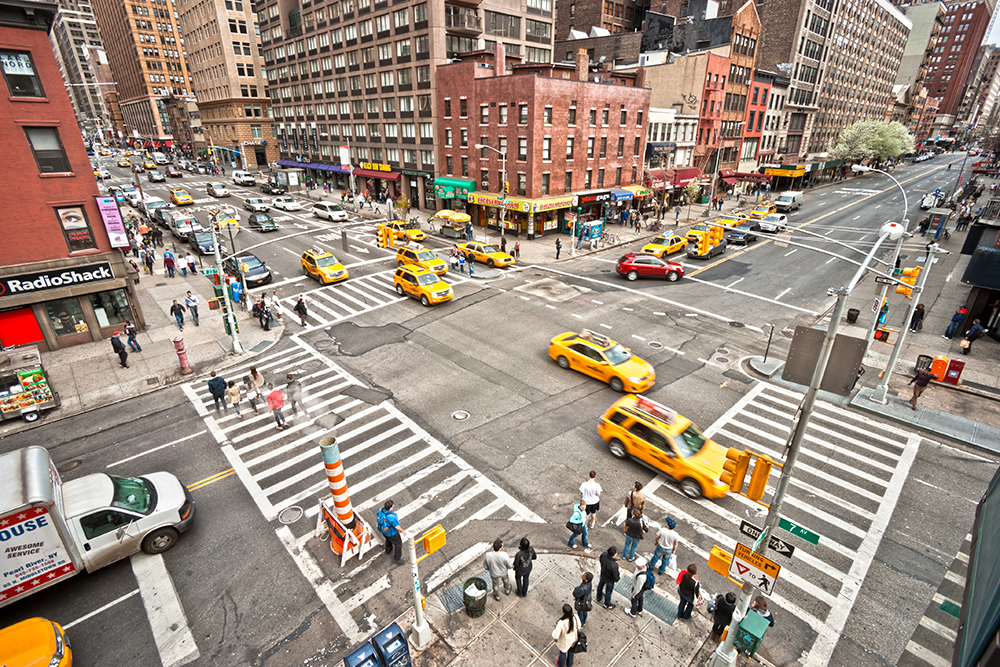
It’s a sad fact of life that, as you get older, you tend not to bounce. Bones are more brittle, muscles are weaker, illnesses and injuries which were brushed off when younger tend to have a more lasting effect as the years advance. Trips and slips take time to recover from, and a fall can be fatal.
This is thrown into stark relief in New York City, where traffic injury and fatality statistics suggest that seniors are not hit by vehicles more often than younger folk – it’s just that they don’t recover so well. Clearly, anyone, of any age, being hit by a vehicle is to be avoided – but seniors make up less than 15% of New York City’s population yet represent over 45% of annual pedestrian fatalities.
The population of New Yorkers aged 65 and older is growing. The rate of senior pedestrian fatalities and severe injuries has actually improved slightly over the last few years, according to a new report from New York City Department of Transportation, Pedestrian Safety and Older New Yorkers, but city authorities have decided that more needs to be done.
Worse outcomes
One revelation is that, when it comes to negotiating the mean streets of the Big Apple, older people act pretty much like the youngsters they once were. “We learned that senior pedestrians are very similar to younger adults in their behaviour and crash patterns and for the most part, they use our streets much like the rest of the population,” explains New York commissioner Ydanis Rodriguez in his foreword to the report.
“They are struck no more often than younger pedestrians; however, when they are hit, they suffer far worse outcomes. Because even minor injuries for seniors can become fatal, total avoidance of crashes must be NYC DoT’s primary street design goal.”
The report sets out in detail the steps which the city must take. New York was not immune from what it calls “an epidemic of reckless driving” across the US as deaths related to driving rose despite the reduced driving activity during various Covid lockdowns. But the report says that Vision Zero principles, which it frequently invokes in its pages, have had success in reducing fatalities: “In fact, seven of the eight safest years in the city’s history have happened since 2014.”
Manhattan is the borough with the highest percentage of older adult pedestrian fatalities citywide, and city mayor Eric Adams has said the lives of the oldest New Yorkers are “so precious” and that the city will “work around the clock to protect them”. While some might dismiss this as hyperbole, there is a plan to go with the survey, with data the key to targeting resources.
Seniors have more difficulty scanning different directions of traffic, NYCDoT says, and older adult pedestrian fatalities are more likely to occur close to home and in the middle of the day.
Improvement pledges
The city pledges to implement ‘10 or more’ street improvements for seniors each year at locations where studies show there is a safety problem. Street improvement projects (SIPs) can include bike lanes, pedestrian islands, kerb and sidewalk extensions. They can also include turn calming, which will be installed at 50 intersections annually and have the potential to cut older pedestrian deaths and serious injuries by up to 60%.
“We are committed to ensuring better crosswalks, traffic lights, and other pedestrian safety measures throughout our city to protect all residents including older adults who are at higher risk of pedestrian injury and death,” congressman Adriano Espaillat said.
The city will “drastically expand” the installation of pedestrian head-starts or leading pedestrian intervals (LPIs) installations by 2024. A focus on street safety and safer street designs has led to the identification of new NYC DoT ‘senior pedestrian zones’ “to guide future engineering, enforcement and education”. These “identify neighbourhoods that have the highest proportion of senior pedestrian injuries relative to the residential population of seniors in that neighbourhood” (see box).
In January, Adams committed to safety design improvements this year at 1,000 intersections, with improved traffic signals, raised crosswalks, and other expanded pedestrian space and visibility measures.
He also committed to expanded enforcement – and the involvement of police is obviously important here. The police have already been looking out for Vision Zero Violations – which are the most dangerous, such as failure to yield, cell phone use, speeding and disobeying traffic control devices – and, the report, says “NYPD will begin a sharper focus on the targeting of dangerous driver behaviour in areas where senior injuries and population are concentrated”.
Left-turn failure-to-yield crashes are nearly twice as deadly for older adults than for younger adults, and account for 35% of older adult pedestrian fatalities. NYPD says it is clamping down on drivers who “fail to recognise the primacy of pedestrians in crosswalks” and has issued 17,810 Failure to Yield summonses citywide for the first half of 2022, a 30.4% increase compared with the 13,651 issued for the same period in 2021.
Dangerous drivers
More older adults are injured or killed while riding their bike than by being struck by a cyclist, the report finds, with Asians overrepresented in older adult pedestrian fatalities. The report suggests this may be due to older Asian populations being prevalent in denser parts of the city (Manhattan Chinatown, Sunset Park, Flushing, Jackson Heights) “where walking rates are higher and car ownership is lower, leading to increased exposure to traffic”.
The report also mentions that NYPD will continue to identify seniors with head injuries for enhanced crash investigations, a practice which began in 2018. The force’s Collision Investigation Squad (CIS) is lead investigator on fatal crashes in the city, supporting the prosecution and conviction of dangerous drivers – but also collating information which helps in NYC DoT’s safety efforts. Minor injuries which do not seem particularly serious at the time can mean that an immediate CIS investigation might not seem like a priority – except that these same injuries can prove fatal for older people days or weeks afterwards. If a crash site is cleared before an investigation begins, then gathering details is more difficult.
The report’s release follows successful efforts by New York City to expand DoT’s speed camera programme to 24/7 operation. “We must make the areas around senior centres even safer, building safer streets that are inclusive to all New Yorkers - but especially those who are most vulnerable,” insists Rodriguez. “Data is always at the forefront of our work, and this study allows us to make targeted investments that will save the lives of seniors citywide.”
“As an age-inclusive city that is committed to providing community care for older New Yorkers, protecting our older adults from traffic injuries and traffic deaths is imperative,” said Department for the Ageing commissioner Lorraine Cortés-Vázquez.
Quite apart from the reasonable expectation of being safe while walking round, the health and wellbeing boost from physical activity – particularly to older adults – is highlighted.
But there is also the question of the personal tragedy that accompanies the statistics and which is ultimately behind the urge to put serious measures in place. NYC DoT will be pleased that safety campaigners have welcomed its efforts.
“Keeping older New Yorkers safe from traffic violence must be a priority for our city’s leaders,” said Families for Safe Streets member Irma Rosenblatt, whose 88-year-old mother was killed by a speeding SUV driver in 2014.
“Crossing the street should not be a life-or-death endeavour but it often is for those who are most vulnerable. Today’s announcement from DoT to invest in safe streets improvements will help keep all New Yorkers safe - especially older New Yorkers.”
Senior pedestrian zones
Senior pedestrian zones are in areas of the city where the most injuries occur involving older people. To determine this, they employ Neighbourhood Tabulation Areas (NTAs), a geography developed by the Department of City Planning, which are collections of census tracts that loosely reflect established New York City neighbourhood boundaries, where at least 15,000 people live. The zones represent the highest quintile of NTAs ranked by senior injuries, normalised by senior population.
Action plan
- NYC DoT says it will make a number of ‘data-driven commitments’:
- Extending LPI crossing times during mid-day in senior pedestrian zones and at new LPI locations by the end of 2024
- Adding LPIs at all feasible intersections on priority corridors in senior pedestrian zones by the end of 2024
- Creating senior turn calming initiative and installing treatments at 50 older adult-targeted intersections annually
- Targeting raised crosswalks to older pedestrians and safety improvements near and at bus stop locations
- Targeting safety improvements to bus stop locations under elevated trains
- Targeting older adult education and outreach to senior pedestrian zones









